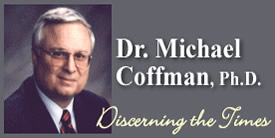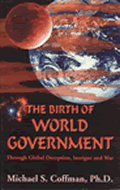Other
Coffman
Articles:
Return to
Earth Worship,
Part 1
How Government Regulations Threaten America
THE WAR ON PROPERTY
RIGHTS & WHAT IT MEANS TO YOU
PART
3 of 3
By
Dr. Michael S. Coffman Ph. D.
August 23, 2006
NewsWithViews.com
The Smart Growth Fraud
Planners claim it costs more to provide urban services to low-density areas, so compact development is more affordable. This claim comes from the report The Costs of Sprawl 2000, which states that low-density development adds a whopping $11,000 to the cost of a new single-family home. However, this is peanuts compared to what Randle O�Tool reports in his enlightening report, The Planning Penalty. Government data shows a nice �middle managers� house with four bedrooms and two-and-one-half baths and a double car garage, costs between $150,000 and $200,000 in American cities having no smart growth or growth-management planning. The price for that same house jumps to $300,000 to 440,000 if that type of planning has been in place for ten to fifteen years. In cities having this planning for twenty-five years or more, the same house costs a staggering $500,000 to as much as $1.5 million.
During the 1990s, the amount of housing stock sold in the United States was slightly more than five percent each year. If the average home is resold or replaced every twenty years, the annual cost of growth-management planning to homebuyers is nearly $275 billion. Leaving out the overpricing of and-short metro areas such as Honolulu, the total planning penalty for the 120 metro areas with such penalties is close to $5.5 trillion, or slightly more than 30 percent of the total value of U.S. owner-occupied housing. We can only expect these costs to grow as more and more communities buy into the smart growth fraud.
O�Tool identifies at least ten causes that create this planning penalty:
-
Urban-growth boundaries, urban-service boundaries, large-lot rural zoning, or other restrictions on the amount of land available for development;
-
Purchases of greenbelts and other open spaces that reduce the amount of land available for development;
-
Design codes requiring developers to use higher cost construction methods or designs;
-
Historic preservation ordinances, tree ordinances, and other rules restricting or increasing the cost of development;
-
Impact fees aimed at discouraging development;
-
Growth caps limiting the number of permits that can be issued each year;
-
Concurrency rules requiring adequate financing for all urban services before building permits can be issued;
-
Lengthy permitting processes that force developers to hold land for several years before they are allowed to develop it;
-
Planning processes that allow people to easily appeal and delay projects, creating uncertainty about when a project can begin;
-
Inclusionary zoning programs requiring developers to subsidize some housing for low-income people, effectively increasing the price of the remaining housing.
Most cities and communities employ many of these at the same time.
This
reality points out an ugly fact about smart growth. It destroys the
American Dream for millions  of
low to middle income Americans. Although smart growth proponents advocate
land-use control as a means of providing affordable housing, it punishes
low-income families, keeping them from ever being able to afford a
home of their own and denying them the American Dream. According to
the Heritage
Foundation, home ownership rates among African-American and Hispanic
families are still below 50 percent, in contrast to the nearly 75
percent ownership rates among white households. The very fashionable
Fauquier County, Virginia, which has imposed severe growth restrictions
and limits on homebuilding, has seen its African-American population
fall both relatively and absolutely over the decade of the 1990s.
of
low to middle income Americans. Although smart growth proponents advocate
land-use control as a means of providing affordable housing, it punishes
low-income families, keeping them from ever being able to afford a
home of their own and denying them the American Dream. According to
the Heritage
Foundation, home ownership rates among African-American and Hispanic
families are still below 50 percent, in contrast to the nearly 75
percent ownership rates among white households. The very fashionable
Fauquier County, Virginia, which has imposed severe growth restrictions
and limits on homebuilding, has seen its African-American population
fall both relatively and absolutely over the decade of the 1990s.
Urban planning has failed miserably in providing affordable housing. As a rule, more dense areas cost more to build in, tend to have higher taxes, higher levels of pollution, and a higher cost of living. The Heritage Foundation reports that; �Data indicate that housing affordability in Portland, Oregon (percentage of households that can afford the median priced home) dropped 56 percent from 1991 to 2000, the largest reduction of any major urban area in the nation! Portland's home ownership rate fell as a result.� The poor, of course, suffer the most in this kind of failed policy.
Families no longer able to afford single-family homes in Portland have to move into �affordable� multifamily units. These units are often subsidized � at taxpayers expense � by the very government that created the shortage in the first place by imposing smart growth regulations. During 1992-97, the number of housing permits issued for multifamily units doubled from 25 percent to 49 percent. Those communities and cities employing smart growth are in fact willfully using the law to plunder, if not criminally extort their citizens. It systematically destroys the hopes and aspirations of the lower income class and those unfortunate souls whom the community targets for destruction.
Smart growth advocates usually blame housing affordability problems on demand. If that were true, then prices of houses would be much higher in Houston, Atlanta and Raleigh, which are among the nation�s fastest growing cities. But they are orders of magnitude less than in San Diego and San Jose, which are growing very slowly.
The
paranoia about the need to control growth is a constant drumbeat of
those promoting urban planning. They claim America is rapidly losing
its  farmland
and open space. Yet, the U.S. Bureau of Census classifies about 6
percent of the U.S. as being developed and 3 percent as urban using
the 2002 corrected data. Even in the densely populated east, both
New York and Pennsylvania are only 10 percent developed. New Jersey,
the most developed state, has only 30 percent of its land developed.
To top it all off, The
National Center for Policy Analysis found that less than one-quarter
of the loss in farmland since 1945 is due to urbanization, and the
rate of loss has been dropping since the 1960s. To state it in the
simplest possible terms, there is no problem with sprawl.
farmland
and open space. Yet, the U.S. Bureau of Census classifies about 6
percent of the U.S. as being developed and 3 percent as urban using
the 2002 corrected data. Even in the densely populated east, both
New York and Pennsylvania are only 10 percent developed. New Jersey,
the most developed state, has only 30 percent of its land developed.
To top it all off, The
National Center for Policy Analysis found that less than one-quarter
of the loss in farmland since 1945 is due to urbanization, and the
rate of loss has been dropping since the 1960s. To state it in the
simplest possible terms, there is no problem with sprawl.
For decades urban planners have adhered to the mantra that urban sprawl increases pollution and housing costs, more driving time to work and shopping, stress, and the escalating consumption of scarce farmland and open space. Urban planning to implement smart growth supposedly corrects these problems and creates more livable, inexpensive homes for all. Irrefutable evidence, however, shows that urban planning creates the very nightmares it is supposed to eliminate. In the process, it strips urbanites of one of their most fundamental civil liberties � property rights.
The presumption that low-density residential development means more pollution, more congestion and fewer preserved natural resources is blatantly false. Likewise, the belief that higher-density compact development mitigates those impacts is false. Increasing population density does little to alleviate auto-caused smog. Urban and suburban areas with the lowest population densities have the fewest air pollution problems.
Population density or compactness also has little relationship to how much commuters depend on automobiles. More than 75 percent of commuter trips are by car � even in urban areas. Thus, any planning strategy that attempts to increase population density usually leads to more traffic congestion and stalled traffic. This exacerbates air pollution levels and potentially causes more areas to fail federal clean air goals. This, in turn requires regulations that are even more restrictive.
Portland, Oregon, the model for urban planning, has had the most stringent land-use plans in the U.S. since the 1970s. Portland�s March 16, 1996 Regional Transportation Update boldly proclaimed that, �Congestion signals positive urban development.� As if that were not bad enough, Portland�s 1999 Regional Transportation Plan proclaims that, �Transportation solutions aimed solely at relieving congestion are inappropriate.� When confronted with the question of why the agency found high levels of congestion to be acceptable, its leading transportation planner replied that any effort to relieve congestion �would eliminate transit ridership.� In other words, light rail and smart growth have become ends unto themselves, unrelated to solving urban problems.
In implementing its plan, Portland has stopped building highways and instead has built two light commuter rails that failed to achieve their goals. Transit commuter use actually dropped 20 percent from 1980 to 1991. Additionally, in spite of the severe hardship imposed on those who want to use automobiles, the Portland area experienced the largest increase in automobile use per capita from 1990 to 1999 of any U.S. urban area with more than one million people.
The same is true for alternative transit methods. San Francisco's proposed Third Street light rail line, for instance, costs $40.50 per ride, which is equal to $18,225 annually per new commuter. Notes the Heritage Foundation:
For the same money, each new commuter could lease a new Pontiac Grand Am throughout the "life" of the rail system and pay for more than 100,000 miles of air travel at the average ticket rate each year. Alternatively, one could lease the Grand Am and use the remainder of the annual subsidy for the average mortgage payment in the nation's most expensive housing market.
At least nineteen states have state growth-management laws or task forces to ostensibly protect farmland and open space. Dozens of cities and counties have adopted urban growth boundaries to contain development and prevent the spread of urbanization to outlying and rural areas. The Department of Housing and Urban Development (HUD) partially funded a 2002 report called Growing Smart Legislative Guidebook: Model Statutes for Planning and the Management of Change. In 2003 Congress considered passing �The Community Character Act,� which proposed to fund state and local efforts to reform their land use planning process to conform more closely to smart growth policies. The Act did not pass, but it will come up again. Count on it.
The Legislative Guidebook calls for using federal funding as a carrot to mandate a more restrictive �integrated state-regional-local planning system that is both vertically and horizontally consistent.� Vertically and horizontally consistent, in turn, means total government control from the federal government to the local community across America.
Contrary to the dogma that condemns sprawl as somehow evil, Randal O�Tool makes these germane observations:
-
Sprawl is the cure for, not the cause of, congestion. As USC planning professors Peter Gordon and Harry Richardson observe, �suburbanization has been the dominant and successful mechanism for coping with congestion.�
-
By providing access to low-cost land, sprawl increases, not reduces, housing affordability.
-
As the U.S. Department of Agriculture says, urbanization is �not considered a threat to the nation�s food production.� Nor is it a threat to forests or other rural open spaces.
-
Sprawl does not make people �auto dependent.� Rather, it gives people opportunities to take advantage of the liberating effects of automobility. Among these effects have been a huge increase in real personal incomes, access to a wide variety of low-cost consumer goods, and increased recreation and social opportunities.
-
Sprawl does not make people fat or unhealthy, and claims to the contrary are based on junkscience. O�Tool reports that find weak correlations between statistically questionable data and then assume that correlation proves causation.
-
Sprawl does not cause toxic air pollution. Concentrations of toxic pollutants are far more likely in dense areas than in low-density areas.
No matter how it is cut, urban planning and smart growth is a bald-faced fraud that is creating a nightmare for people across America. As Randal O�Tool said in The Planning Penalty, �It is hard to imagine that more traffic congestion, higher taxes, lower urban services, increased consumer costs, and unaffordable housing add up to a more livable city.�
|
Subscribe to the NewsWithViews Daily News Alerts! |
From
a few academics and environmentalists to the media, state and local
officials, and high-level federal officials of all ideologies and
party affiliations, this misguided vision has spread despite overwhelming
evidence that it does not work. The persistence of these beliefs despite
all facts to the contrary is a tribute to the power of a fashionable
idea favoring federal intervention, however illogical it may seem
in practice and experience.
� 2006 Michael Coffman - All Rights Reserved
Dr. Michael S. Coffman received his BS in Forestry and MS in Biology at Northern Arizona University at Flagstaff, Arizona and his Ph.D. in Forest Science at the University of Idaho at Moscow in 1966,1967, and 1970 respectively. Since then he has become a respected scientist and ecologist who has been involved in ecosystem research for over twenty years in both academia and industry. He taught courses and conducted research in forest ecology and forest community dynamics for ten years at Michigan Technological UniversityCa leading forestry school in the Midwest. While there, he published a book on forest ecosystem classification in Upper Michigan and Northern Wisconsin, which has become the standard for classification in the region. He also assisted the U.S. Forest Service in developing an Ecological Land Classification System for each of the National Forests in Region-9.
Until 1992 Dr. Coffman was a manager for Champion International, a leading forest and paper products company in the United States. During his tenure with Champion, he became Chairman of the Forest Health Group within NCASI (National Council for the Paper Industry for Air and Stream Improvement), a respected scientific research group for the Paper Industry. In this, and other related responsibilities, he was responsible for millions of dollars of research and became intimately involved in such national and international issues as acid rain, global climate change, wetlands, cumulative effects and biological diversity. During this time he was a spokesperson for the Paper Industry for the media.
Dr. Coffman is currently President of Environmental Perspectives, Inc. He also serves as Executive Director of Sovereignty International, Inc and the Local Environment and Resource Network (LEARN). He provides professional guidance and training in defining environmental problems and conflicts, and developing solutions to specific issues as well as the hidden dangers of international treaties and agreements that threaten our Constitutional protections, especially property rights. He played a key role in stopping the ratification of the Convention on Biological Diversity (Biodiversity Treaty) in the U.S. Senate one hour before the ratification vote by anticipating and exposing the unbelievable agenda behind the treaty. He has written three books exposing the environmentalist phenomenon; The Birth of World Government, Saviors of the Earth? The Politics and Religion of Environmentalism, and Environmentalism! The Dawn of Aquarius or the Twilight of a new Dark Age?
In his present capacity as Exec. Director of Sovereignty International, Inc. he is intimately involved with the science that drives the issue of global warming and sustainable development and global political agenda behind the effort to create global governance. Dr. Coffman speaks to a variety of groups nationally who are interested in the scientific truth and political agenda behind global warming and other environmental issues to advance global governance.
LEARN provides knowledge to local citizens on how to help local government attain equal powers with the federal and state governments in implementing environmental laws in order to protect both the environment and the rights of local citizens.
E-Mail: mcoffman@adelphia.net
No matter how it is cut, urban planning and smart growth is a bald-faced fraud that is creating a nightmare for people across America.











